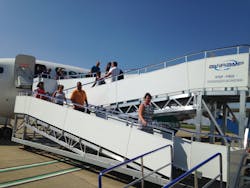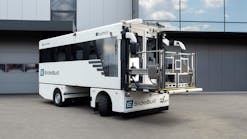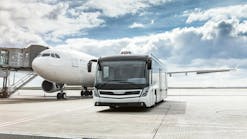Aviramp Caters To The PRM Market With A Ramp Fit For All Passengers
A UK company manufacturing an interesting take on an aircraft boarding ramp for remote stands secured a major order last summer from Dallas Fort Worth International Airport. An order for seven so-called Aviramps worth $660,000 was secured by Ra’alloy Ramps.
Although designed in particular to help passengers with reduced mobility get on and off aircraft, the Aviramp allows all passenger’s to board together.
Traditionally, people with impaired mobility have had to be carried up and down the air stairs by handlers or taken away from other passengers and boarded on a modified truck.
One key to the Aviramp design is the gentle 8-degree slope that makes aircraft access easy for those pushing a wheelchair and for PRM.
Aviramp features automatic braking systems, speed control, a spring-loaded docking plate and since they are made of aluminum as well as steel to keep the weight down the portable ramp can be controlled by just one operator.
Commercial airline pilot and Aviramp co-developer Adam Corfield previously worked for the low cost airline industry and he knows first-hand that a common delay on making turns in such cases was waiting for specialized equipment to help disabled passengers.
“With Aviramp costing roughly 18 percent of a traditional high lift, the airport or ground service provider gains the ability to release capital investment from sales plus eliminating a huge maintenance cost, " Corfield explains. "In turn, this provides the airport and GSP an opportunity to operate with a more modern and cost effective strategy."
The buyers at DFW initially bought two different models, which service the Airbus A319 and Boeing 737, at the beginning of last year for evaluation, before following up with two more, smaller, models which service smaller regional jets. Corfield said he was surprised when another order came in, including for an international model which is to be used on aircraft such as the Airbus A380.
GETTING STARTED
Ra’alloy Ramps started in 1994 by making ramps for cars and trucks all designed for easing disabled access and efficiently loading and unloading material.
It became involved in improving access in the aviation industry by chance after a Norwegian airport spotted its website. Eventually, the firm was contacted by Oslo Airport, which was looking for a better way to help passengers with limited mobility on and off aircraft.
Closer to its home base of Shropshire, UK, Ra'alloy began designing and testing ramps with UK-based airline Easyjet. The airline's ground operations staff had researched this idea in the past, but were unable to find any company willing to develop such a passenger boarding ramp.
The company’s first trails in 2011, quickly delivered results:
- Passengers boarded and disembarked quicker by up to 9 minutes on a full A319 aircraft.
- Disabled travelers and passengers with reduced mobility were happy to board with all other passengers.
- Wheelchairs could be pushed up the ramp with one attendant due to gentle slopes.
The equipment also had additional benefits that went behind the PRM market:
- Children could board safely without the fear of them falling down stairs.
- General passengers preferred walking on the ramp instead of climbing and descending stairs, particularly with luggage.
Since the initial trials many airports and airlines are operating Aviramp aircraft boarding jet bridges globally and developing the step free airport concept.
Current customers include ground service provider Swissport in Japan, airports in Japan, Kuwait, Italy, France and the US and carriers including Qatar Airways, Jetstar and Qantas (which has just taken five units of the hand-pulled Aviramp Lite model).
Aviramp‘s Managing Director Graham Corfield comments: “Aviramp is at its central stage of global expansion, Aviramp is well-positioned to achieve its global strategic objectives with a strong product and a clear mission statement for the future. We plan to return investment into the business which in turn is great news for our operations. We have already had to expand our operations by 400 percent and move to a larger manufacturing plant."






